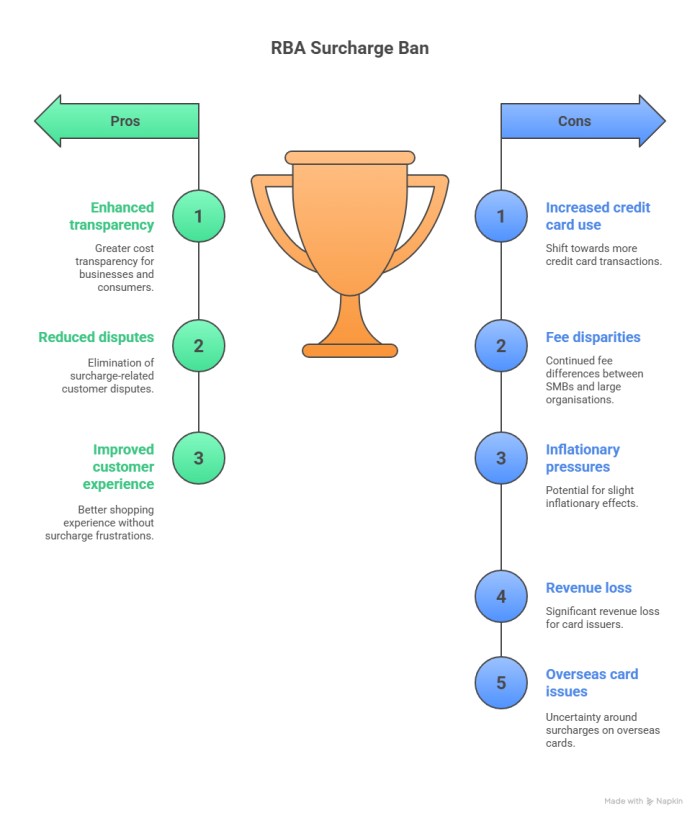
The Reserve Bank of Australia's (RBA) ban on surcharges for debit and credit card payments, proposed to take effect on 1 July 2026, will, if accepted, significantly reshape the payment methods used in your store. This reform targets surcharging fees that retailers add to transactions paid for using Visa and Mastercard.
I am building on my article from yesterday, which sparked lively discussions. Let's explore the key issues you should consider.
Firstly, this proposal does not address the cause of why people charge these surcharges; the symptom of the surcharge is not the cause. Nor does it address the fact that SMB businesses pay significantly higher fees than larger organisations, often 350% more. The only point mentioned here that is relevant is the greater transparency in the costs. However, it's become quite transparent now. When I reviewed my EFTPOS and credit charges last time, I got, among other documents, a charge table showing the rates the bank would charge depending on my turnover and average transaction value.
If the proposal is accepted, likely fallouts include reduced cash transactions, increased credit card usage, continuing fee disparities between SMBs and large organisations, and some inflationary pressures.
Exploring the Key Fallouts if the Proposal Proceeds
Why Cash Might Fade Faster
Cash has long been popular for small, everyday purchases, such as a quick coffee or a newspaper at your local shop. Its appeal lies in the simplicity and lack of fees for both you and the customer. However, with surcharges banned, the cost barrier between cash and cards vanishes for consumers. Why would they dig for coins when tapping a card costs the same? This shift would further diminish the role of money, accelerating a trend already evident in Australia, which is what the Australian government aims to achieve.
Beyond diminishing cash use, we can expect to see a greater use of credit cards, as this ban would also equalise charges, leading to another key shift: many will ask, Why use debit when they can get credit for free?
Debating the Consumer Savings and Business Losses
The RBA estimates that Australian consumers could save nearly $1.2 billion annually if the proposal is implemented, equating to approximately $60 per card-using adult. This figure is debatable. Much of this money will shift elsewhere in the system, rather than disappear. That $1.2 billion represents a substantial loss to Australian businesses, particularly the large issuers of debit and credit cards, who stand to take significant revenue hits if the reforms proceed in their current form without changes.
Fee Hikes
Major banks will seek to recover losses from lowered interchange fees.
Running payment networks for Visa, Mastercard, and EFTPOS is enormously expensive. The cost of infrastructure, security, and global operations costs won't disappear under this plan.
Banks will need to pass these costs on somewhere. They might increase cardholder fees, such as annual charges or interest rates. But hiking merchant fees through administration charges is more likely.
Uncertainties Around Overseas Cards and Surcharging
It's unclear whether the plan will allow surcharges on overseas cards, such as American Express or a Visa issued in Singapore. I suspect that some form of surcharging will still be permitted for international transactions. It creates a pain point, as we will need to distinguish between domestic and foreign cards at checkout, which is long overdue. If this is done, we can adapt our POS systems to automatically detect card types, allowing us to handle surcharges without slowing down service.
Potential Inflationary Effects and Price Adjustments
Many businesses that currently apply surcharges are already considering price increases to compensate for the lost revenue. If you are among them, this approach makes sense to protect your margins, but it will contribute to slight inflationary pressures across the economy. If you are affected here, this will require careful handling to avoid alienating price-sensitive customers.
Turning Challenges into Opportunities with Practical Strategies
It's not all downside, as I stated yesterday, these changes will eliminate surcharge-related disputes, thereby fostering a better shopping experience. The reality is that customers hate surcharges.
With the timeline in 2026, you have time to prepare.
One idea worth considering is offering cash discounts after the ban is lifted. It remains an allowable option and can encourage customers to choose cash, thereby reducing your fee exposure. For example, one of my clients offers a free can of drink if the transaction is over $30 and is paid in cash. It worked well.
You need to consider how to adapt your payment strategy.
Written by:

Bernard Zimmermann is the founding director of POS Solutions, a leading point-of-sale system company with 45 years of industry experience, now retired and seeking new opportunities. He consults with various organisations, from small businesses to large retailers and government institutions. Bernard is passionate about helping companies optimise their operations through innovative POS technology and enabling seamless customer experiences through effective software solutions.


